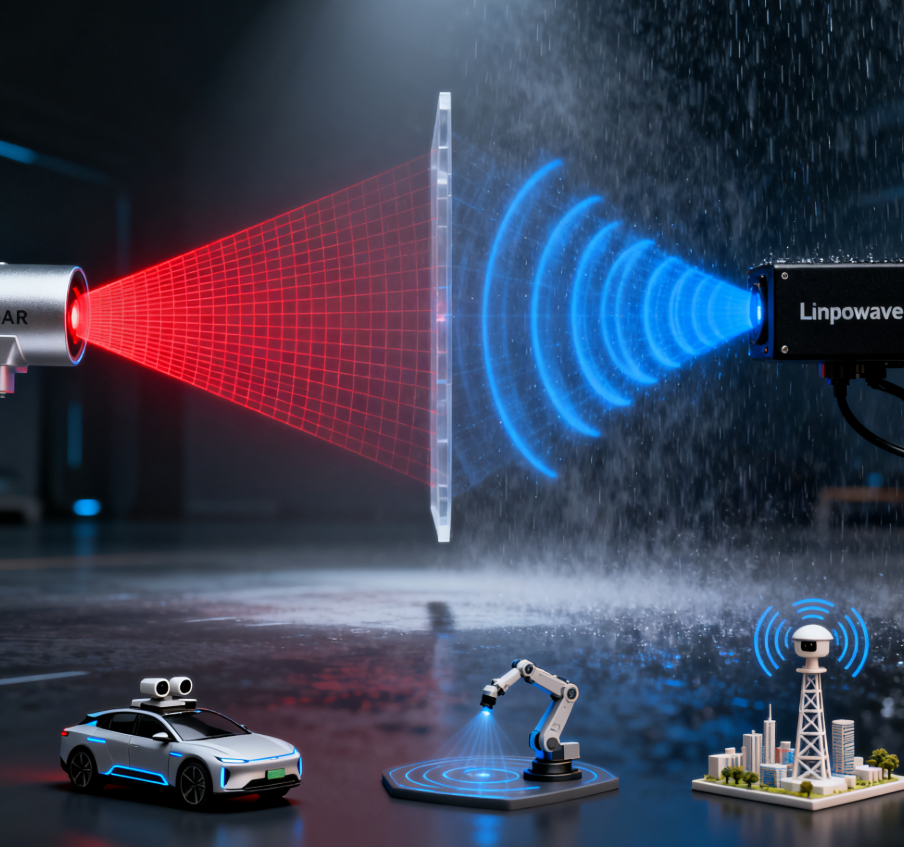Introduction
In modern sensing technologies, LiDAR and mmWave radar are often discussed as the primary solutions for autonomous vehicles, robotics, drones, and smart infrastructure. While both provide environmental awareness, they operate on fundamentally different principles, making them suitable for distinct applications.
Linpowave mmWave radar modules offer high-precision detection in harsh conditions, and understanding how they compare to LiDAR is crucial for system designers, integrators, and end-users. This blog provides a detailed comparison, explores use cases, and highlights the advantages of mmWave radar for real-world deployments.
How LiDAR Works
LiDAR (Light Detection and Ranging) uses laser pulses to measure distances to objects. Key characteristics:
-
High Resolution – Generates detailed 3D maps, ideal for object classification and obstacle recognition.
-
Short to Medium Range – Typical range is 30–200 meters depending on the system.
-
Vulnerability to Environmental Conditions – Performance may degrade in fog, rain, snow, or direct sunlight.
-
Data-Intensive – Produces large amounts of 3D point cloud data, requiring high processing power.
LiDAR excels at detailed mapping and precision detection, making it suitable for autonomous navigation in controlled or predictable environments.
How mmWave Radar Works
Millimeter-wave radar operates in the 30–300 GHz frequency band, sending electromagnetic waves and analyzing reflections. Key features:
-
All-Weather Performance – Functions reliably in rain, fog, dust, and snow.
-
Longer Range Detection – Detects moving and stationary objects up to hundreds of meters.
-
Velocity Measurement – Measures Doppler velocity, enabling accurate motion tracking.
-
Low Data Load – Provides essential data (range, velocity, azimuth, elevation) efficiently, reducing processing requirements.
Linpowave modules are designed for automotive, industrial, and smart infrastructure applications, offering robust, real-time sensing where LiDAR may struggle.
LiDAR vs mmWave: Key Comparisons
| Feature | LiDAR | mmWave Radar (Linpowave) |
|---|---|---|
| Range | Short to medium (30–200m) | Medium to long (up to 300m) |
| Resolution | Very high (3D point cloud) | Moderate (range, azimuth, elevation) |
| Weather Performance | Sensitive to fog, rain, dust | Robust in all weather conditions |
| Velocity Measurement | Limited | Accurate Doppler velocity detection |
| Data Processing | High computing requirement | Efficient, low data load |
| Privacy | Generates detailed environmental images | No visual imaging, privacy-friendly |
| Cost | High | Cost-effective for multi-sensor deployment |
Real-World Applications
-
Automotive and ADAS
-
LiDAR is used for precise lane detection and 3D mapping.
-
Linpowave mmWave radar enables collision avoidance, blind spot detection, and adaptive cruise control, even in poor weather.
-
-
Smart Cities and Infrastructure
-
Radar can monitor traffic flow, detect pedestrians, and track vehicles, supporting V2X systems.
-
LiDAR excels in detailed 3D mapping for urban planning but requires clear conditions.
-
-
Drones and Robotics
-
LiDAR provides high-resolution 3D environment mapping.
-
mmWave radar enables obstacle detection and velocity tracking in foggy, dusty, or rainy environments.
-
Advantages of Linpowave mmWave Radar
-
Weather-Resilient Sensing – Works in extreme environments where LiDAR may fail.
-
Cost-Effective Multi-Sensor Deployment – Enables full coverage with fewer units.
-
Velocity Tracking – Detects moving objects reliably in real time.
-
Privacy-Friendly – Does not capture images, suitable for sensitive environments.
Linpowave modules are modular, scalable, and easy to integrate into automotive, smart city, and industrial IoT systems.
FAQ: LiDAR vs mmWave Radar
Q1: Can mmWave radar replace LiDAR entirely?
It depends on application. For detailed 3D mapping, LiDAR is preferred. For all-weather detection, velocity measurement, and privacy-sensitive environments, mmWave radar is ideal.
Q2: Are Linpowave radar modules compatible with LiDAR in sensor fusion systems?
Yes. Combining LiDAR and mmWave radar provides redundancy, enhanced accuracy, and robust sensing in all conditions.
Q3: What is the typical range and accuracy of Linpowave radar?
Linpowave automotive modules detect objects up to 200–300 meters, with precise range, azimuth, and velocity measurements suitable for ADAS and industrial use.
Q4: How do mmWave radar and LiDAR compare in cost?
LiDAR systems are generally higher cost due to lasers and optics. mmWave radar is more cost-effective, especially for multi-sensor applications.
Future Outlook
-
Sensor Fusion Growth – Combining LiDAR, mmWave radar, and cameras will enhance autonomous vehicle reliability.
-
Industrial IoT Applications – mmWave radar adoption in warehouses, factories, and robotics will increase due to robustness and efficiency.
-
Smarter Cities – Urban sensing networks will leverage mmWave radar for all-weather traffic and pedestrian monitoring.
Linpowave is at the forefront of mmWave radar innovation, providing scalable, reliable, and efficient solutions for a wide range of applications.
Conclusion
While LiDAR excels at high-resolution 3D mapping, mmWave radar, particularly from Linpowave, offers robust, all-weather, cost-effective, and privacy-friendly sensing. Understanding the strengths of each technology allows developers to deploy hybrid systems or select the right sensor for their application, ensuring reliable performance in the real world.
👉 Explore Linpowave Radar Solutions to learn how mmWave radar complements LiDAR and supports automotive, industrial, and smart infrastructure applications.



